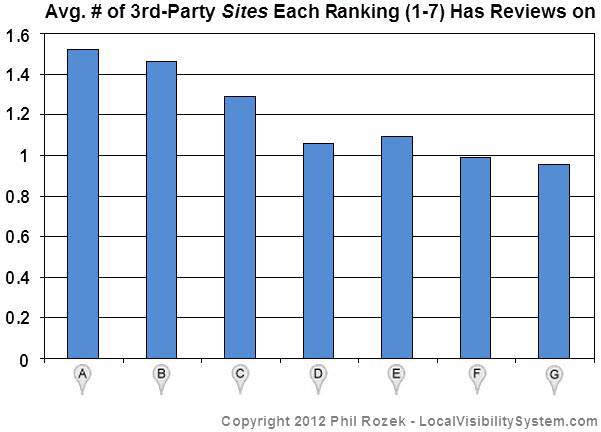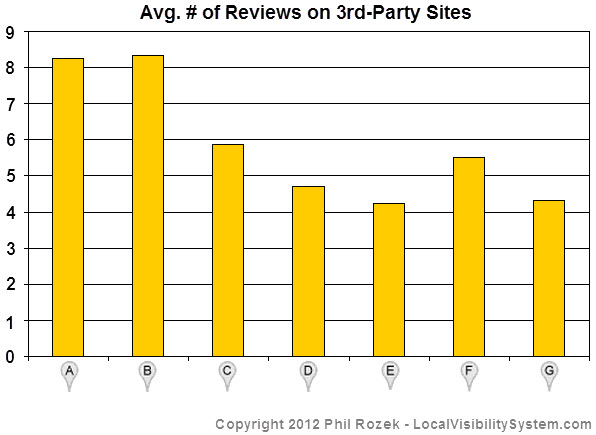Customer reviews are crucial to your local rankings and overall success in Google Places, as you may know. You need reviews that customers write directly on your Google Places page, and you need customer reviews on third-party sites like InsiderPages, CitySearch, etc.
We know that the first type of reviews—“Google reviews,” written directly on your Places page—have a strong influence on Google Places rankings. That’s well-established, and I’ve seen it to be the case throughout the 3 years I’ve been specializing in Google Local.
But what about reviews written on third-party sites? Yeah, they’re important. But what else do you know about third-party reviews and how they relate to your Google Places rankings? Probably not much more or less than I did before I did a little fact-finding on the topic.
I took a “core sample” of 200 local markets and 1400 businesses in Google Places, in all different industries and cities in the US.
(Back in July of last year I did similar research, but that was on “Google reviews” and third-party reviews collectively. This time I’m focusing on the third-party ones.)
Obviously this wasn’t exhaustive research—if it was, I’d be using my break from collecting data to shop around for some glass eyeballs. However, I’ve got enough figures to answer some specific questions about how third-party reviews tie into first-page Google Places rankings.
“How many different third-party sites does a top-7 business have customer reviews on, on average?”
When you’re on a given Places page, how many distinct sites are shown as having reviews for that business? For example:

What I wanted to know is how the number of third-party review sites corresponds to Google Places rankings. Here’s what I found:

Here are the naked numbers for the chart (that is, how many different third-party sites each ranking has customer reviews on):
A = 1.52
B = 1.46
C = 1.29
D = 1.06
E = 1.095
F = 0.99
G = 0.955
What do these numbers tell us?
First of all, there is a correspondence between the Google Places ranking of a business and how many third-party sites it has customer reviews on. Maybe you intuitively knew that already, but now you have some numbers.
The top-3 rankings have customer reviews on more sites than rankings #4-7 do. The difference is even clearer between A-B and F-G: rankings A-B generally have reviews on 1-2 third-party sites, whereas the lower rankings tend to have reviews on just one third-party site. That’s a ratio of 3:2. Put another way, the businesses at the top of the Google Places “7-pack” typically have customer reviews on 50% more third-party sites than the businesses at the bottom of the 7-pack have.
The numbers also tell us that if your business is in the top-7 of Google Places, chances are you’ve got customer reviews on at least one third-party site—meaning a medium other than Google Places or Yelp.com (because Yelp reviews no longer show up on Google Places pages).
This helps affirm what I’ve told my clients for a long time, and what Mike Blumenthal has suggested for quite a while: that you can’t simply rely on the reviews that customers write on your Places page. If you’re serious about getting a top-7 Google Places ranking, one good place to start is with asking some of your customers to write you reviews on at least one third-party site (InsiderPages, SuperPages, YellowPages, CitySearch, or another).
“How many third-party reviews does a top-7 business have, on average?”
Here’s what I found:

And again, the plain numbers for how many third-party reviews each ranking has (on average), between all the third-party sites where customers have posted reviews:
A = 8.255
B = 8.335
C = 5.87
D = 4.71
E = 4.235
F = 5.515
G = 4.325
What does this tell us?
The top-2 rankings have significantly more reviews than rankings C-G (3-7). Once again, we’re seeing a difference of 50-100% between the top of the “7-pack” and the rest of it.
Again, this doesn’t count Google Places reviews (which obviously aren’t “third-party”) or Yelp reviews (which Google Places no longer uses).
Most of all, we’ve got a couple more handy ballpark numbers that you can work into your customer-review strategy:
- If you’d like to get into the Google Places top-7, you should probably try to get at least 5 customer to write reviews on at least one third-party site.
- Or if you’re already in the local top-7 and trying to get to the very top, your strategy should include getting at least 30-100% more customer reviews on third-party sites than the other top-7 businesses have. In terms of reviews, there’s a big gap between #1 and #7.
“So how should I change my reviews strategy?”
Time for a recap. Use the following as rules-of-thumb as you move forward:
1. Don’t just focus on Google Places reviews; ask customers to review you elsewhere, too
2. There’s a correspondence between your ranking and how many third-party sites you’re reviews on. You’ll probably need reviews on one such site in order to get into the top-7. But the more different third-party sites your customers can review you on, the better
3. There’s also a correspondence between your ranking and how many total third-party reviews you have. Ranking in the top-2 will probably require that you get 30-100% more customer reviews than your page-one local competitors have.
4. If you’re trying to get into the Google Places top-7, a good initial benchmark is to get at least 5 customer reviews on at least one third-party site (SuperPages, CitySearch, etc.
5. If you want to climb higher in the Google Places 7-pack, shoot for a total of about 8 reviews on at least 2 different third-party sites
—
By the way, you can download my spreadsheet with all the data, in case you’d like to roll up your sleeves and handle some numbers.
Of course, I’d appreciate your weighing in—leave a comment!